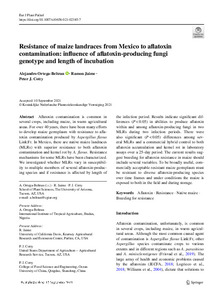| dc.contributor.author | Ortega-Beltran, A. |
| dc.contributor.author | Jaime, R. |
| dc.contributor.author | Cotty, P. |
| dc.date.accessioned | 2022-09-21T08:14:00Z |
| dc.date.available | 2022-09-21T08:14:00Z |
| dc.date.issued | 2021-09-15 |
| dc.identifier.citation | Ortega-Beltran, A., Jaime, R. & Cotty, P. (2021). Resistance of maize landraces from Mexico to aflatoxin contamination: influence of aflatoxin-producing fungi genotype and length of incubation. European Journal of Plant Pathology. 162, 237–246 . |
| dc.identifier.issn | 0929-1873 |
| dc.identifier.uri | https://hdl.handle.net/20.500.12478/7785 |
| dc.description.abstract | Aflatoxin contamination is common in several crops, including maize, in warm agricultural areas. For over 40 years, there have been many efforts to develop maize germplasm with resistance to aflatoxin contamination produced by Aspergillus flavus Link:Fr. In Mexico, there are native maize landraces (MLRs) with superior resistance to both aflatoxin contamination and kernel rot by A. flavus. Resistance mechanisms for some MLRs have been characterized. We investigated whether MLRs vary in susceptibility to multiple members of several aflatoxin-producing species and if resistance is affected by length of the infection period. Results indicate significant differences (P < 0.05) in abilities to produce aflatoxin within and among aflatoxin-producing fungi in two MLRs during two infection periods. There were also significant (P < 0.05) differences among several MLRs and a commercial hybrid control to both aflatoxin accumulation and kernel rot in laboratory assays over a 25-day period. The current results suggest breeding for aflatoxin resistance in maize should include several variables. To be broadly useful, commercially acceptable resistant maize germplasm must be resistant to diverse aflatoxin-producing species over time frames and under conditions the maize is exposed to both in the field and during storage. |
| dc.description.sponsorship | United States Department of Agriculture |
| dc.format.extent | 237–246 |
| dc.language.iso | en |
| dc.subject | Aflatoxins |
| dc.subject | Resistance |
| dc.subject | Maize |
| dc.subject | Breeding |
| dc.subject | Plant Breeding |
| dc.title | Resistance of maize landraces from Mexico to aflatoxin contamination: influence of aflatoxin-producing fungi genotype and length of incubation |
| dc.type | Journal Article |
| cg.contributor.crp | Agriculture for Nutrition and Health |
| cg.contributor.crp | Maize |
| cg.contributor.affiliation | International Institute of Tropical Agriculture |
| cg.contributor.affiliation | University of California Davis |
| cg.contributor.affiliation | United States Department of Agriculture |
| cg.coverage.region | Latin America |
| cg.coverage.country | Mexico |
| cg.coverage.hub | Headquarters and Western Africa Hub |
| cg.researchtheme | Plant Production and Health |
| cg.identifier.bibtexciteid | ORTEGABELTRAN:2021e |
| cg.isijournal | ISI Journal |
| cg.authorship.types | CGIAR and advanced research institute |
| cg.iitasubject | Aflatoxin |
| cg.iitasubject | Agronomy |
| cg.iitasubject | Food Security |
| cg.iitasubject | Maize |
| cg.iitasubject | Plant Breeding |
| cg.iitasubject | Plant Health |
| cg.iitasubject | Plant Production |
| cg.journal | European Journal of Plant Pathology |
| cg.notes | Published online: 15 Sep 2021 |
| cg.accessibilitystatus | Limited Access |
| cg.reviewstatus | Peer Review |
| cg.usagerightslicense | Copyrighted; all rights reserved |
| cg.targetaudience | Scientists |
| cg.identifier.doi | https://dx.doi.org/10.1007/s10658-021-02385-7 |
| cg.iitaauthor.identifier | Alejandro Ortega-Beltran: 0000-0003-3747-8094 |
| cg.futureupdate.required | No |
| cg.identifier.volume | 162 |
| cg.contributor.acknowledgements | We are grateful to all maize farmers who donated the maize landrace accessions used in this study. |

